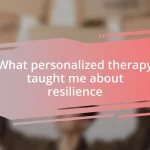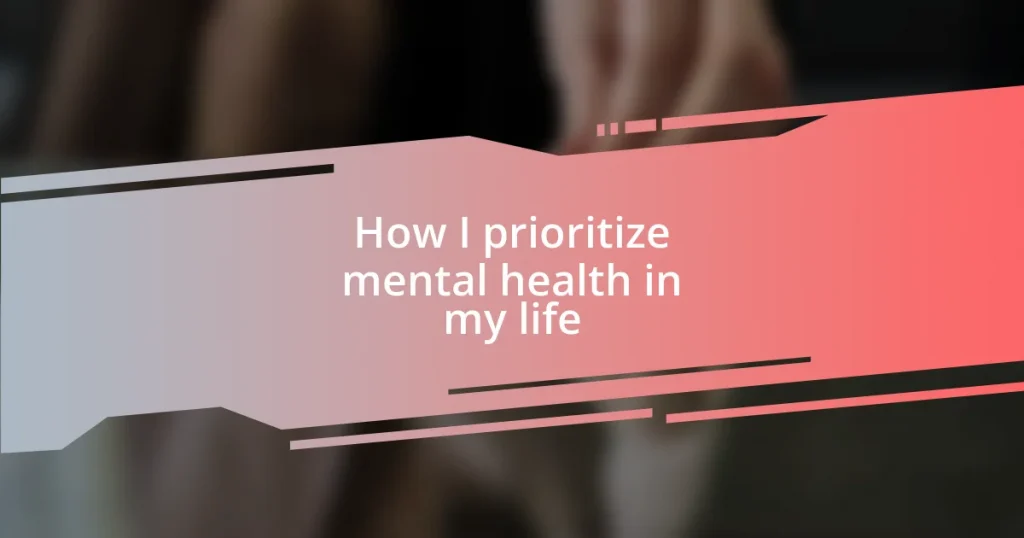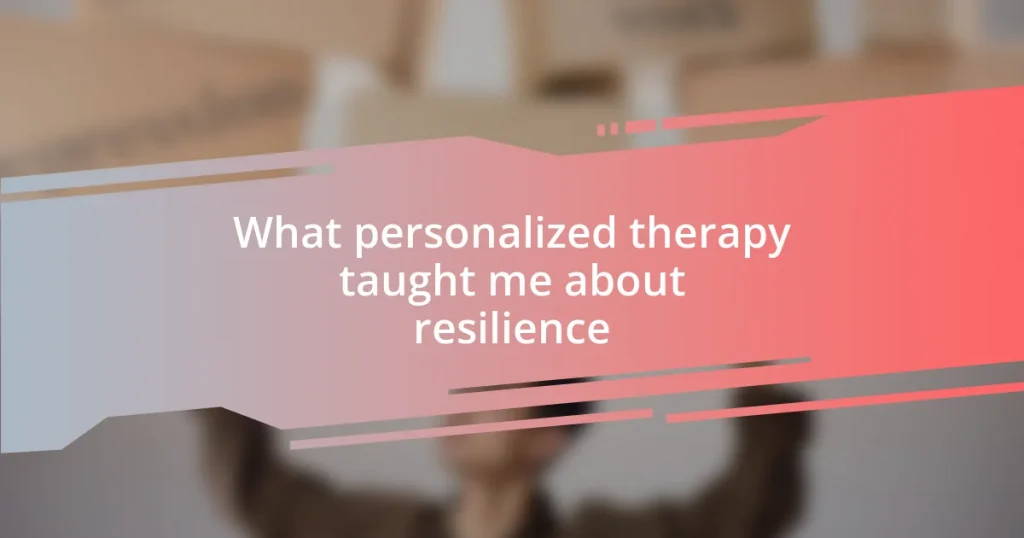Key takeaways:
- Prioritizing mental health is crucial for overall well-being, enhancing relationships, and productivity.
- Daily habits like mindfulness, exercise, and gratitude journaling are essential for maintaining mental wellness.
- Seeking professional help can be a transformative step in managing mental health challenges and gaining clarity.
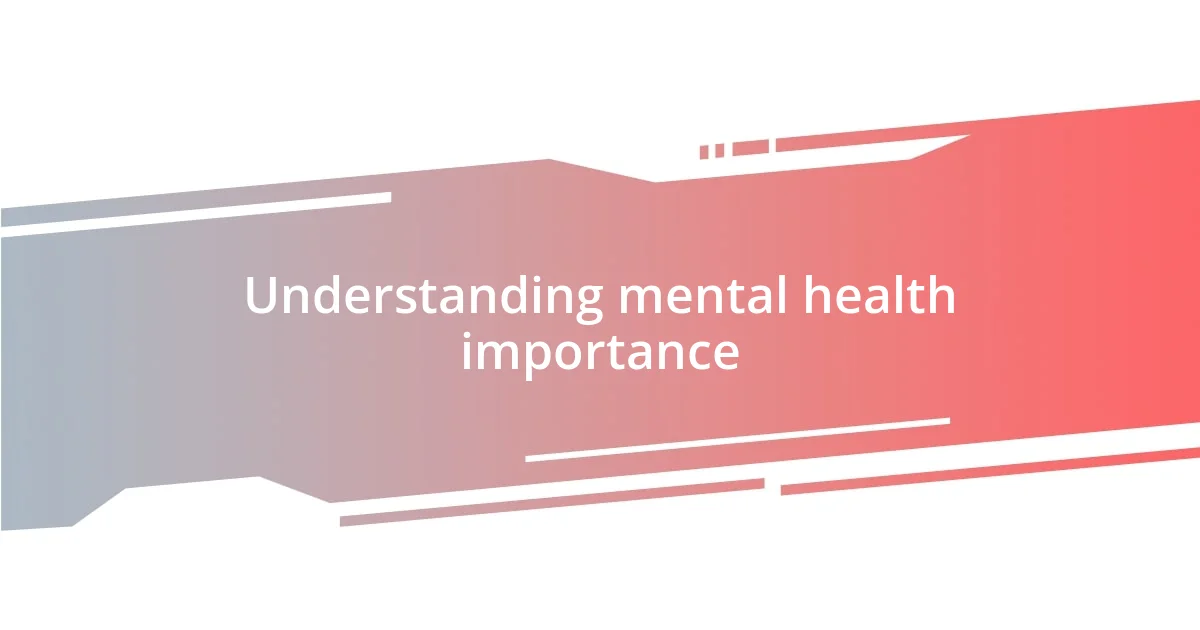
Understanding mental health importance
Understanding the importance of mental health is a realization I’ve come to appreciate deeply. I remember a period when I was overwhelmed by work stress; it felt like I was walking through fog. Reflecting on that time, I often wonder, how much could I have achieved if I’d prioritized my mental well-being earlier?
Mental health isn’t just the absence of illness; it’s about thriving in life. I’ve observed that when I take care of my mental landscape, my relationships flourish, and my overall productivity soars. It makes me think: Isn’t it fascinating how intertwined our mental and emotional states are with our day-to-day experiences?
Ultimately, neglecting mental health can lead to a cascade of negative outcomes, both personally and socially. I once let anxiety dictate my choices, hindering my connection with loved ones. It’s a lesson that still resonates with me—without nurturing our mental health, we risk losing touch with what truly matters in life.
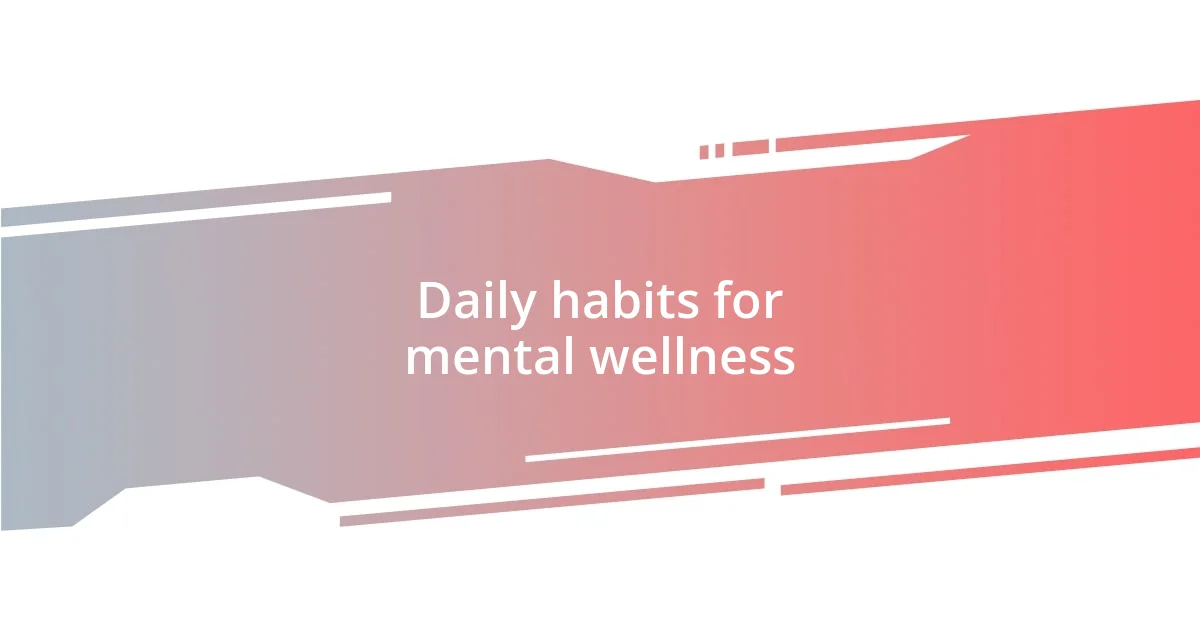
Daily habits for mental wellness
Daily habits are the glue that holds my mental wellness together. Over the years, I’ve discovered that simplicity often leads to profound change. For instance, I make it a point to start my day with a few minutes of mindfulness. This small practice helps me center my thoughts and set a positive tone for the day ahead. I’ve noticed that when I skip this, I’m more prone to stress and distractions.
Here are some daily habits I prioritize for my mental wellness:
- Morning Mindfulness: Even five minutes of deep breathing or meditation can shift my mindset significantly.
- Exercise: A short walk or a quick workout releases endorphins, boosting my mood.
- Gratitude Journaling: Writing down three things I’m grateful for each day helps me maintain perspective and stay grounded.
- Healthy Eating: I pay attention to my diet because what I consume affects my energy levels and mood.
- Digital Detox: I set aside time each day to unplug from screens and social media, which reduces anxiety and cultivates presence.
These routines not only fortify my mental health but also provide me with a toolkit that I can lean on during tougher days. They remind me that self-care isn’t selfish; it’s a necessity.
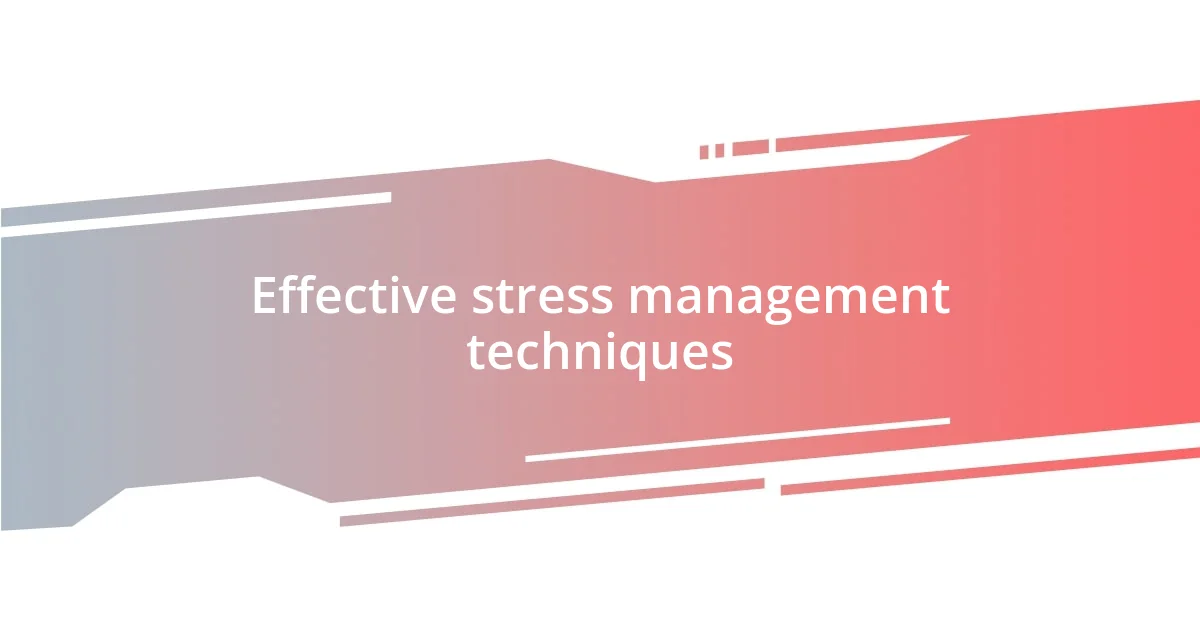
Effective stress management techniques
Effective stress management techniques are essential for maintaining mental health, and I find that different techniques resonate with me at various times. For instance, I’ve discovered that physical activity is one of the most effective stress busters. On days when I feel overwhelmed, a brisk walk outside—preferably in nature—can dramatically shift my mood and help clear my thoughts. It’s remarkable how movement can release pent-up energy and allow me to approach challenges with a fresher perspective.
Mindfulness practices, such as meditation or focused breathing exercises, play a pivotal role in my stress management toolkit. I recall a time when anxiety about an upcoming presentation almost paralyzed me. Instead of succumbing to that pressure, I took ten minutes to focus on my breath, grounding myself in the present moment. Afterward, I felt significantly calmer and more equipped to tackle my fears head-on. These moments of stillness serve as anchors in my chaotic life, reinforcing my belief that pausing can be just as powerful as action.
I’ve also incorporated creative outlets to combat stress. Whenever I engage in painting or journaling, I lose track of time and immerse myself fully in the process. This creative expression allows me to explore my feelings, providing a healthy way to process emotions and release tension. I truly believe that finding an activity that fills you with joy is crucial in navigating the stresses of life.
| Technique | Description |
|---|---|
| Physical Activity | Engaging in exercise, like walking or yoga, boosts mood and helps reduce anxiety levels. |
| Mindfulness | Practices such as meditation improve focus and decrease feelings of overwhelm. |
| Creative Outlets | Activities like painting or journaling facilitate emotional expression and promote relaxation. |
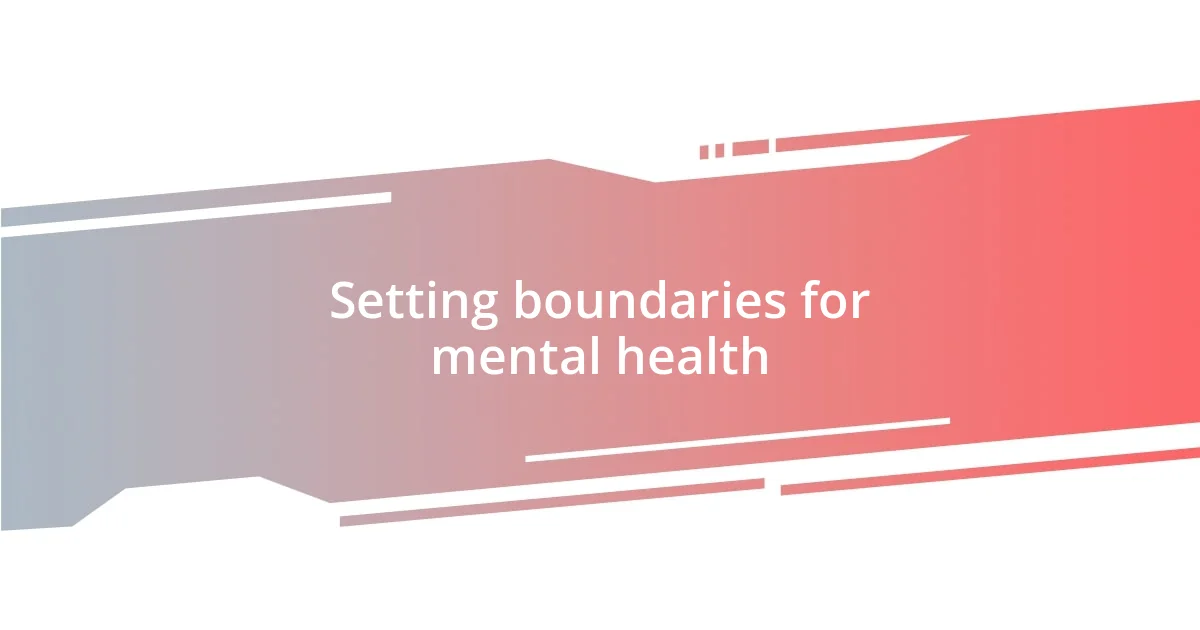
Setting boundaries for mental health
Setting boundaries is one of the most effective tools I’ve learned for nurturing my mental health. I remember a time when I was overwhelmed, feeling pulled in countless directions by friends, family, and work obligations. It was during this chaotic period that I decided to set specific limits on my availability. I learned that saying “no” doesn’t equate to being rude; rather, it allows me to prioritize my well-being and show up fully when it truly matters.
Another key aspect of boundary-setting is creating a designated space for myself. For instance, I set aside certain hours each day to disconnect from work emails and social media. This boundary creates a much-needed breath of fresh air in my daily routine, shielding me from the constant influx of information. I think about how much lighter I feel during those moments of uninterrupted solitude. Doesn’t everyone deserve a bit of time away from the digital noise?
Emotional boundaries are equally important. I’ve had to learn how to protect my feelings and energy during conversations that drain me. Sometimes, stepping away from tense discussions or toxic environments is necessary for maintaining my sanity. It’s about recognizing my limits and respecting them, which leads to a healthier mindset. When I reflect on these practices, I can honestly say that my mental well-being has flourished as a result of consciously setting these boundaries.
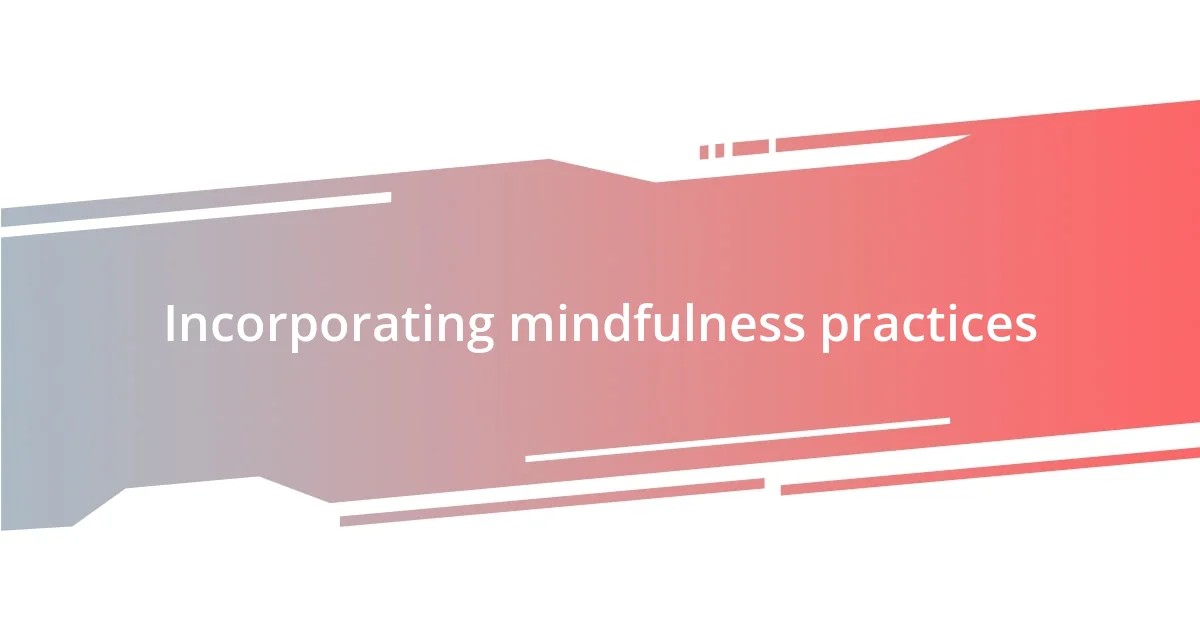
Incorporating mindfulness practices
When I first jumped into mindfulness practices, I didn’t realize how transformative they could be. One day, feeling particularly stressed after a long week, I stumbled into a local meditation class, unsure of what to expect. The moment I closed my eyes and focused on my breath, I felt an overwhelming sense of calm wash over me. I often wonder how many people miss out on this feeling simply because they haven’t tried it yet.
Incorporating mindfulness into my daily routine has been a game-changer, especially during hectic mornings. I’ve started setting aside just five minutes to practice mindful breathing before diving into my day. This simple act not only grounds me but also enhances my focus. I’ve noticed that on days when I skip this practice, I tend to feel frazzled and reactive instead of calm and centered. Isn’t it amazing how such a small commitment of time can yield significant benefits?
I find that being mindful while performing everyday activities can help maintain that sense of peace throughout the day. For instance, when I wash my dishes, I consciously pay attention to the warmth of the water and the scent of the soap. This might sound unusual, but I often feel the tension in my shoulders ease as I immerse myself in these small, sensory moments. It makes me realize that mindfulness doesn’t require a special setting; rather, it can be woven into the fabric of our daily lives. Have you ever noticed how these little moments can drastically shift your perspective?

Engaging in physical activity

Engaging in physical activity
Engaging in physical activity is something I cannot overlook in my mental health routine. There was a phase when I felt sluggish and unmotivated, only to realize that I hadn’t moved my body enough. This realization prompted me to lace up my sneakers and hit the nearby park for a brisk walk. The fresh air rejuvenated me, and I remember thinking, “How did I let myself forget such a simple source of joy?”
I’ve discovered that it doesn’t always have to be an intense workout to feel the benefits. On particularly stressful days, I might opt for gentle yoga or just dance in my living room to my favorite tunes. It’s incredible how physical movement can shift my mood. There’s this euphoric moment, often dubbed the “runner’s high,” that I experience, even if I’m not running. Have you ever noticed a correlation between how much you move and how you feel?
Regular exercise has also given me a chance to connect with others. I cherish those weekend hikes with friends where we share laughter and stories while soaking in nature’s beauty. These moments have taught me that physical activity can be both an individual and social experience. It’s a cathartic escape from our busy lives, reminding me that taking a break to move is not just an activity, but a vital part of nurturing my mental health.

Seeking professional help when needed
Seeking professional help has been one of the most significant turning points in my mental health journey. I remember the first time I walked into a therapist’s office, feeling a mix of embarrassment and desperation. I kept questioning, “Why can’t I handle this on my own?” But after a few sessions, I realized that seeking help wasn’t a sign of weakness; it was an act of courage and a step towards healing.
There have been moments when I felt overwhelmed, and talking to a professional provided clarity I desperately needed. I recall discussing my feelings of burnout and anxiety during one session, and my therapist introduced me to the concept of cognitive behavioral therapy (CBT). Through CBT, I learned how my thoughts impacted my emotions and behaviors, allowing me to challenge negative patterns. Have you ever considered how a different perspective can change everything?
Now, whenever I encounter similar feelings, I remind myself that it’s perfectly okay to reach out for help. It’s like having a trusted road map on a journey that can often feel chaotic. I understand that not everyone has the same experiences with therapy, but I encourage anyone feeling stuck or anxious to at least explore this avenue. After all, isn’t it reassuring to know there are trained professionals ready to support us? Getting that help can genuinely transform our lives for the better.


